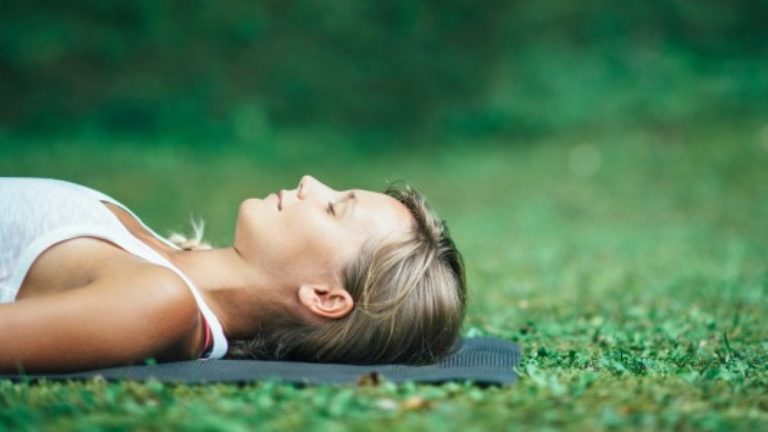Using Deep Relaxation Meditation for Better Sleep: Practices and Tips

Are you tired of tossing and turning in bed, struggling to fall asleep? Look no further! In this article, we will guide you through the practice of deep relaxation meditation to help you achieve better sleep.
Discover the amazing benefits of this technique and learn how it works scientifically.
Follow our step-by-step guide to incorporate deep relaxation meditation into your bedtime routine and create the ideal environment for a restful night’s sleep.
Say goodbye to sleepless nights and hello to rejuvenating rest!
Key Takeaways
- Deep relaxation meditation can improve sleep quality and reduce insomnia symptoms.
- It releases tension and stress, promoting overall well-being.
- Deep relaxation meditation activates the relaxation response, releases calming neurotransmitters and hormones, and regulates sleep-wake cycles.
- Incorporating deep meditation into a bedtime routine can lead to increased mental clarity, reduced stress levels, greater sense of inner peace, improved focus, and reduction in anxiety levels.
Benefits of Deep Relaxation Meditation for Sleep
Deep relaxation meditation can provide numerous benefits for better sleep. By incorporating this practice into your bedtime routine, you can significantly improve your sleep quality and reduce insomnia symptoms.
When you practice deep relaxation meditation, your body and mind enter a state of deep relaxation, allowing you to release tension and stress that may be keeping you awake at night. This practice also helps to calm your mind, quieting the constant stream of thoughts that often disrupt sleep.
As a result, you can experience a more restful and rejuvenating sleep, waking up feeling refreshed and energized. Additionally, deep relaxation meditation promotes a sense of overall well-being, helping you to manage anxiety and promote relaxation throughout the day, leading to better sleep at night.
Understanding the Science Behind Deep Relaxation Meditation
By understanding the science behind relaxation meditation, you can gain insight into its effects on your sleep quality.
Deep relaxation meditation involves activating the body’s relaxation response, which counteracts the stress response. This process triggers the release of calming neurotransmitters and hormones, such as serotonin and melatonin, which help regulate sleep-wake cycles. Deep meditation also reduces the production of cortisol, a stress hormone that can disrupt sleep.
Additionally, this practice increases alpha brainwave activity, associated with relaxed and wakeful states. By regularly engaging in deep relaxation meditation, you can experience improved sleep quality, reduced sleep disturbances, and increased sleep duration.
It is important to note that the benefits of deep meditation for sleep may vary for individuals, so it is best to experiment and find a practice that works best for you.
Step-by-Step Guide to Practicing Deep Relaxation Meditation
If you’re looking for effective techniques for relaxation, exploring deep meditation can offer you a multitude of benefits.
Deep meditation not only helps you relax and unwind, but it also has numerous physical and mental health benefits.
In addition, practicing deep meditation regularly can improve the quality of your sleep, offering you a better night’s rest.
Effective Techniques for Relaxation
One effective technique for relaxation is practicing guided meditation before bed. Deep relaxation meditation can help calm your mind, release tension, and prepare your body for a restful sleep. Here are four effective techniques for achieving deep relaxation through meditation:
- Deep Breathing: Begin by taking slow, deep breaths. Inhale deeply, filling your lungs, and exhale slowly, releasing any stress or tension.
- Progressive Muscle Relaxation: Starting from your toes, tense and then relax each muscle group in your body, working your way up to your head. This helps release physical tension and promotes a state of relaxation.
- Visualization: Imagine yourself in a peaceful, serene location, such as a beach or a forest. Visualize the sights, sounds, and smells of this place, allowing yourself to fully immerse in the experience.
- Guided Meditation: Use a guided meditation audio or app to help you relax and guide you through the meditation process. Follow the instructions and allow yourself to be guided into a deep state of relaxation.
Benefits of Deep Meditation
The benefits of practicing deep meditation include increased mental clarity, reduced stress levels, and a greater sense of inner peace. By incorporating deep meditation into your daily routine, you can improve your focus and reduce anxiety.
Deep meditation allows you to quiet your mind and let go of the constant thoughts and worries that may be weighing you down. As you delve into a state of deep relaxation, your mind becomes more clear and focused, allowing you to concentrate on tasks with greater ease.
Additionally, deep meditation helps to reduce anxiety by calming your nervous system and releasing tension from your body. As you practice deep meditation regularly, you will notice a remarkable improvement in your ability to stay focused and a significant reduction in anxiety levels, leading to a more peaceful and balanced state of being.
Tips for Better Sleep
To improve your sleep, try establishing a consistent bedtime routine that includes relaxation techniques such as deep breathing and gentle stretching. By incorporating these practices into your routine, you can promote relaxation and improve the quality of your sleep.
Here are four tips to help you get started:
- Set a regular sleep schedule: Going to bed and waking up at the same time every day helps regulate your body’s internal clock, making it easier to fall asleep and wake up refreshed.
- Create a calming environment: Make sure your bedroom is cool, dark, and quiet. Consider using earplugs, an eye mask, or a white noise machine to block out any distractions.
- Limit screen time before bed: The blue light emitted by electronic devices can interfere with your sleep. Try to avoid screens at least an hour before bedtime.
- Practice relaxation techniques: Deep breathing exercises, progressive muscle relaxation, or guided meditation can help calm your mind and prepare your body for sleep.
Creating the Ideal Environment for Deep Relaxation Meditation
When practicing deep relaxation meditation, it’s important to create an ideal environment that promotes calmness and relaxation.
One key aspect to consider is lighting and ambiance – dimming the lights or using soft, soothing lighting can help create a tranquil atmosphere.
Additionally, comfortable seating arrangements are crucial to ensure that you can fully relax and focus on your meditation practice.
Lighting and Ambiance
Creating a calming ambiance with soft lighting can enhance the effectiveness of your deep relaxation meditation practice for better sleep. The lighting techniques you incorporate into your meditation space can greatly impact your ability to relax and find tranquility.
Here are four ways to create a calming atmosphere through lighting:
- Use warm, gentle lighting: Avoid harsh, bright lights that can be jarring to the senses. Instead, opt for soft, warm lighting that creates a cozy and soothing atmosphere.
- Dim the lights: Lowering the intensity of the lights can help signal to your brain that it’s time to wind down and relax. Consider using dimmer switches or lamps with adjustable brightness.
- Choose natural light sources: Whenever possible, incorporate natural light into your meditation space. Sunlight has a calming effect on the mind and can enhance the overall peacefulness of your practice.
- Use candles or fairy lights: The soft flickering of candles or fairy lights can create a tranquil and magical ambiance. These gentle sources of light can help you enter a state of deep relaxation and promote better sleep.
Comfortable Seating Arrangements
Incorporating comfortable seating arrangements can greatly enhance your meditation experience.
Creating a cozy space for your practice involves finding the right meditation cushion. When selecting a cushion, consider its height, firmness, and material. Look for a cushion that provides adequate support for your body while allowing you to maintain a relaxed and upright posture. Choose a cushion that feels comfortable for extended periods of sitting.
Additionally, you may want to include a soft blanket or meditation shawl to help keep you warm during your practice.
Incorporating Deep Relaxation Meditation Into Your Bedtime Routine
If you’re looking to add deep relaxation meditation to your bedtime routine, it can be beneficial for improving sleep quality. Incorporating mindfulness techniques and breathwork techniques can enhance the effectiveness of your meditation practice.
Here are four ways to incorporate these techniques into your bedtime routine:
- Mindful body scan: Lie down in a comfortable position and bring your attention to each part of your body, starting from your toes and moving up to your head. Notice any tension or discomfort and intentionally release it, allowing your body to relax completely.
- Box breathing: Focus on your breath and inhale deeply for a count of four, hold your breath for a count of four, exhale for a count of four, and hold your breath for a count of four again. Repeat this pattern several times, allowing your breath to slow down and calm your mind.
- Loving-kindness meditation: Send loving and compassionate thoughts to yourself, loved ones, and even to those you may have difficulty with. This practice can cultivate feelings of warmth and relaxation, promoting a peaceful state of mind before sleep.
- Guided visualization: Listen to a guided meditation that takes you on a journey through a peaceful and serene place. Use your imagination to immerse yourself in the sights, sounds, and sensations of this place, allowing your mind to let go of any tension or worries.
Incorporating these mindfulness and breathwork techniques into your bedtime routine can help you relax deeply, quiet your mind, and improve the quality of your sleep.
Troubleshooting Common Challenges in Deep Relaxation Meditation for Sleep
When experiencing challenges with deep relaxation meditation for sleep, it’s important to identify and address the factors that may be hindering your practice. Troubleshooting these challenges can help improve your focus and enhance the effectiveness of your meditation sessions. One common challenge is a wandering mind, where thoughts and distractions constantly invade your practice. To overcome this, try using techniques like focusing on your breath or repeating a mantra to anchor your attention. Another challenge is physical discomfort, such as an uncomfortable position or a restless body. Ensure that you are in a comfortable position and make any necessary adjustments to alleviate discomfort. Lastly, external distractions like noise or interruptions can disrupt your meditation. Consider finding a quiet and peaceful environment or using noise-canceling headphones to minimize distractions.
| Troubleshooting Challenges | Improving Focus |
|---|---|
| Wandering mind | Focus on breath or mantra |
| Physical discomfort | Adjust position for comfort |
| External distractions | Find a quiet environment or use headphones |
Frequently Asked Questions
What Are Some Alternative Techniques for Deep Relaxation Meditation?
There are a couple of alternative techniques for deep relaxation meditation that you can try. One is visualization, where you imagine peaceful scenes. Another is body scan meditation, where you focus on each part of your body.
Can Deep Relaxation Meditation Cause Any Negative Side Effects?
Deep relaxation meditation can have potential negative effects, such as drowsiness or disorientation. However, it also offers numerous benefits for your overall well-being, including reduced stress, improved sleep, and increased mindfulness.
How Long Does It Typically Take to See Results From Deep Relaxation Meditation for Better Sleep?
It typically takes a few weeks to see results from deep relaxation meditation for better sleep. However, there are alternative techniques for deep relaxation meditation that may provide faster results.
Is It Necessary to Meditate in Complete Silence for Deep Relaxation Meditation to Be Effective?
For better sleep, you don’t need complete silence when meditating. Meditating with background music or using guided meditation can be effective for deep relaxation and better sleep.
Can Deep Relaxation Meditation Be Used as a Replacement for Sleep?
No, deep relaxation meditation cannot be used as a replacement for sleep. While it can help improve sleep quality, it is not a substitute for the restorative effects of a full night’s rest.








